Caverns for Beginners
I had felt for a while that before sticking my head into a dive site with lots
of rock over my head some extra training might be in order. OK, I dived UK
wrecks and if I thought the place might silt up I have used a reel to run out a
line, Ariadne, Theseus, the Minotaur and the Laberinth style, but I'd never
been caught out...
I then read Martyn Farr's book 'The Darkness Beckons' and although I loved the
glossy pictures I read the text and had no illusions about silt, and the
prospect of dieing lost and alone under water under rock didn't appeal.
Cowards, as they say, live longer and the coward in me postponed the idea of
cave diving indefinitely.
Then a post on uk.rec.scuba pointed me to the
Farrworld website. The maestro was teaching. Not only teaching master class to
dive gods but basics to numpties. I was interested but, at the time I was a
newbie rebreather diver with enough on my plate already. I did make one attempt
to sign up for a course in the spring of this year but it didn't work
out.
Then Sixsquid posted a 'trip report' on the
Yorkshire Divers webforum describing just the course I wanted and, in a
follow up, noted there were spaces on just that course the next weekend. I don't
think I'm impulsive but that was the easy way to make it happen.
After a slightly problematic exchange of emails I was booked, I took the Friday
afternoon off to drive down to Wales and, after a visit to my daughter and
granddaughter in Chepstow, I ended up in a room in the Bear in Crickhowell
(nice but overpriced). This was about the first time I got to stop and think
about what I was just going to do.
Now even I have to confess that scuba divers are nutters, we go to places where
even basics like breathing can't be assumed, however cave divers take it a
whole leap beyond that. The heroes of cave diving are people who have
extended 'the line' in atrocious conditions to the final 'choke' beyond which
no human being will fit.
No Nigel. No. No way. No how. Forget it.
 So why am I here? Well I've been in pot-holes. Well that's what we used to call
them. In my twenties I was quite a good rock climber and some friends, probably
hoping to turn me to the dark side, took me pot holing to try. My main memories
are of finger climbing icy waterfalls, crawling on my tummy through mud and
standing in big chambers being told it would be really spectacular if we had
more lights. Frankly when you come down to it it was Farr's book. The bad
stories don't get into you brain with the immediacy of the pictures.
So why am I here? Well I've been in pot-holes. Well that's what we used to call
them. In my twenties I was quite a good rock climber and some friends, probably
hoping to turn me to the dark side, took me pot holing to try. My main memories
are of finger climbing icy waterfalls, crawling on my tummy through mud and
standing in big chambers being told it would be really spectacular if we had
more lights. Frankly when you come down to it it was Farr's book. The bad
stories don't get into you brain with the immediacy of the pictures.
So on Saturday morning the sat-nav delivers me to Martyn's front door and I end
up sitting at the table working through the usual diet of forms and releases.
Jason, my fellow student arrives and we are introduced to Martyn's team of
Helen and Peter. After the administration of tea we are in the shed to view
some slides and do a kit review.
Right. Reels aren't what I'm used too. If you are going to lay a line that you
can follow out in a total silt-out wearing serious gloves it needs to be good
big line that you can feel. Read that as rope. Big rope with big reels to
match.
Helmets? Old style canoeing helmets without internal padding with torches held
on by elastic.
He does a nice line in octopus holders. Well reg holders actually. It's a
bungee loop to go round your neck feed through a plastic tube to keep them
apart. Pinch clips attach them and then snoopy loops made from bicycle inner
tube.
Everything has to be to hand. Knives aren't on your legs or on your waist but
on your arms. Bending down for something might not be possible.
And snoopy loops. Slices cut from various sizes of inner tube. You can do
anything with snoopy loops. You need lots of them. A snoopy loop round your
quick release weight belt renders it a very non-quick release. If you wonder
why imagine being pinned to the roof of a cave looking down at your weight belt
lying on the floor below you, down by the exit. Snoopy loops to tie off line
to things, to attach things and generally make connections that will pull apart
and fumble together in thick gloves blacked out by silt.
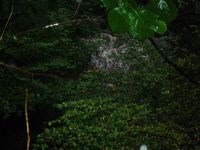 Anyhow once we have seen the slide show lecture and piled the kit in our cars
we are off to go and lay some line. We drive up to a site we have seen pictures
of. Martyn hesitates. He looks down through the trees and pronounces it 'too
rough'. I looked and saw a bit of river white water rafters might describe as
'too rough' but it probably wasn't the same bit. I remind myself that although
cave divers might be insane this one has a track record of coming back alive so
he isn't going to kill me. We drive off to a reservoir.
Anyhow once we have seen the slide show lecture and piled the kit in our cars
we are off to go and lay some line. We drive up to a site we have seen pictures
of. Martyn hesitates. He looks down through the trees and pronounces it 'too
rough'. I looked and saw a bit of river white water rafters might describe as
'too rough' but it probably wasn't the same bit. I remind myself that although
cave divers might be insane this one has a track record of coming back alive so
he isn't going to kill me. We drive off to a reservoir.
Now this is a totally different prospect. Acres and acres of flat water. From
the ridiculous to the sublime. OK climbing through a fence in full scuba gear
was a novel experience but I'm game. We end up on the 'beach' and Martyn briefs
us on the line laying exercise.
Dive One
The vis wasn't so good. By the time we'd started messing about with the line
it alternated between zero in dark red and zero in black with occasional bursts
of 30 cms. My helmet torches made not the slightest difference.
I confess that on two occasions I lost the line. This is the cardinal sin of
cave diving. Lose the line and you are dead. I have a reel bungeed to my
shoulder to use as a search system to try and find it again but here I can
cheat and stand up as the max depth at the bottom of the hole we found was 1.9
meters. This may not be true next time I loose a line.
Jason has first go and I am second. I am groping for rocks that are big
enough to stay put and snoopy looping the line to them. Jason is following
putting extra points between mine. I loose the reel a one point but I still
have the line so I get it back. Remember this is a reel you could put your
garden hose on. Finally we retrace our steps removing the rocks and reeling the
line back up.
"I don't need to do the blacked out mask drill" says Martyn, "because you've
already done it. I don't think I'll use this site again".
All we have left for the day is an air share. We know to stay close and when
the tap on the helmet comes I can take Jason's octo and swim on up the line
together. We had at least a whole meter of vis for this. It wasn't the fastest
swap but I was freediving the weekend before so what's a 20 second change over?
We crawl out and change. It is raining but I am ceasing to care.
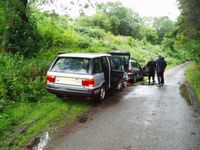
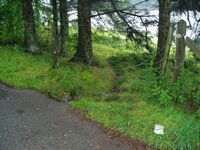
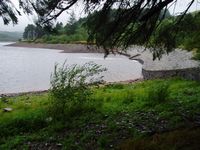

Back to Martyn's and then to the hotel. I throw myself in the shower and eat
the packed lunch I had bought and never managed to find time for. We are to
reconvene at a pub at 8pm for some more class from Peter. Good stuff. I walk
to the pub which was a mistake. The walk there was OK but the walk back was
hard going. I sleep like the dead.
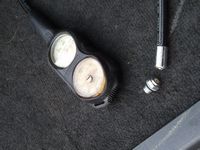 Sunday morning comes and getting up is hard but breakfast is very welcome. I
can't be seasick today so I tuck in, it will give the cholesterol busters I
take something to do. Check out and pay. I go out to the car to set up the kit
and discover the bumps on the road home yesterday have broken the high pressure
feed on my (well my son's) reg set. Still I'm the guy known for carrying too
much kit so I have a spare. Swap in the new 12L cylinder. 230 bar -
tick.
Sunday morning comes and getting up is hard but breakfast is very welcome. I
can't be seasick today so I tuck in, it will give the cholesterol busters I
take something to do. Check out and pay. I go out to the car to set up the kit
and discover the bumps on the road home yesterday have broken the high pressure
feed on my (well my son's) reg set. Still I'm the guy known for carrying too
much kit so I have a spare. Swap in the new 12L cylinder. 230 bar -
tick.
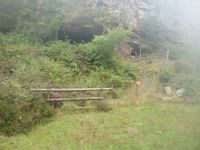 Martyn redoes the brief and we head off to the Dinas Silica Mine. This is a
mine exploiting a seam that slopes at about 20 degrees from the horizontal.
There are a series of east-west horizontal passageways and, as you go south,
they get deeper and deeper. Martyn and his team have put a green line that runs
down from a partially flooded passage to a fully flooded one, along that for
about 50 meters, up to the higher level, back down, along again for another 50
and up again. This is the point we are to turn at. About 100 meters total run
but, due to the linking passageways, never more then 30m from a surface.
Martyn redoes the brief and we head off to the Dinas Silica Mine. This is a
mine exploiting a seam that slopes at about 20 degrees from the horizontal.
There are a series of east-west horizontal passageways and, as you go south,
they get deeper and deeper. Martyn and his team have put a green line that runs
down from a partially flooded passage to a fully flooded one, along that for
about 50 meters, up to the higher level, back down, along again for another 50
and up again. This is the point we are to turn at. About 100 meters total run
but, due to the linking passageways, never more then 30m from a surface.
Dinas is accessible only for certain meanings of accessible. It is a 600
meter carry over a 40 meter hill. And it's a Welsh 40 meter hill on a steep
rocky track and ends in a final flourish with two wire fences to cross. It is
two carries because one was the suit, kit and weight belt and the second was
the cylinder and BCD. It took zen tricks to bring my heart rate down as I was
changing into the drysuit or the cylinder wouldn't have lasted 10
minutes.
Dive Two
I'm not going to pretend I did very well here. I had learnt my lesson on lines
and stuck to it like glue and didn't disturb or pull it. Cave divers are very
protective of their lines. However I totally missed the light signals. We swam
out our 100 meters with Jason leading, turned and with me now in front came
back.
With 50 meters to go the signal came. Lights out. I have the line in my hand
and I follow it along. Buoyancy control blind is easier than I expected. Now
every tie off is a huge complication, every rock dumped on the line a black-out
but I find the turn and follow up to where the line is tied off to a piece of
railway track. I know it goes on. I just can't find it. I am not letting go of
the line. I search. After a while Jason's fingers hit mine and I finally
locate the next section of line and put it in his hand. I reach the first tie
off and follow our line into the air. End of dive two.
I'm not going to claim the lights out drill was a load of laughs, but nor can I
claim I could have been unduly worried at any point with two instructors on
watch and my lights only switched off not failed but I'm glad I've done it.
That is a good trick to have in your mental tool-box so you can tell yourself
"Been there, done that" if you get a real live torch failure. Also remember I
had another torch on the other side of my helmet and yet another in my drysuit
pocket. Running out of torches would be silly but you can't control
silt.
Dive Three
Re-brief for dive three sitting in the water and recalculate the thirds as we
are on OC gear. I have 135 bar, over half a tank, so 100 bar is my turn gas.
I take the reel, check the cluster of snoopy loops snoopy looped to my left
knee and set off. It isn't hard and I have lots of rocks of a reasonable size
to hitch too so it easier than yesterday plus I can see. I alternate the
attaching styles paying careful attention to what it would be like following
the line blind. When I hit the airspace that is the change over point I have
110 bar. I suggest they leave me and Jason, on a 15L tank, has his go at line
laying and I do my reel up drill when they get back. I suspect that that was
what Martyn had in mind but I suggested it as I felt that offering to be left
was better than him asking me to be left. I was in a passage that I could walk
back to the surface but being alone in a cave and watching your colleagues dive
away from you is a novel experience. Fortunately I don't suffer from
claustrophobia or a fear of the dark so I switched out my torch, blew up my
suit to stay warm and relaxed. Gosh I didn't know so much of my gear glowed in
the dark.
I actually enjoyed this interlude. After a while I heard them splashing about
where the line was due to end in another shaft like mine and then silence as
they came back. As soon as I saw torches appearing I turned mine back on and
was ready to take over again. It all went smoothly with Jason popping the
loops and ties off and me just reeling up the line. I snagged it once round the
spindle and had to stop and sort it out but that was just going too fast. We
crawled out, debriefed and changed.
I haven't mentioned Helen much up to here but she actually featured in a backup
and support roll all weekend but as I was changing she announced she was going
back to the car park, she was taking my cylinder, give her my car keys. She
didn't ask, she just told me that is what was happening. Helen you are
wonderful. Thank you for not giving me the opportunity to say no. I hauled my
rucksack with torches, regs, reels and a weight belt back over that mountain
but it was only one trip. Down to the pub to debrief and then back to Martyn's
house to hand back the kit.
The last debrief of a course is always the painful one and this one was no
exception. You get reminded of things that you did and you know they were
wrong. You get asked questions and you know the answer now but you didn't do it
that way. Finally we were told that we hadn't done that badly. We had passed
the practical bits and all we had to do was send in the open book exam paper
with the registration fee and we were Cavern Divers.
I'm sorry there aren't many pictures. I confess I had other things on my
mind.

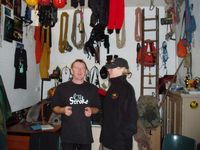

The pictures can be accessed by clicking the thumbnail but they
tend to be 900K+ files
Pictures by Nigel Hewitt
Thumbnails by Easy
Thumbnails

 by Nigel Hewitt
by Nigel Hewitt
 So why am I here? Well I've been in pot-holes. Well that's what we used to call
them. In my twenties I was quite a good rock climber and some friends, probably
hoping to turn me to the dark side, took me pot holing to try. My main memories
are of finger climbing icy waterfalls, crawling on my tummy through mud and
standing in big chambers being told it would be really spectacular if we had
more lights. Frankly when you come down to it it was Farr's book. The bad
stories don't get into you brain with the immediacy of the pictures.
So why am I here? Well I've been in pot-holes. Well that's what we used to call
them. In my twenties I was quite a good rock climber and some friends, probably
hoping to turn me to the dark side, took me pot holing to try. My main memories
are of finger climbing icy waterfalls, crawling on my tummy through mud and
standing in big chambers being told it would be really spectacular if we had
more lights. Frankly when you come down to it it was Farr's book. The bad
stories don't get into you brain with the immediacy of the pictures.
 by Nigel Hewitt
by Nigel Hewitt